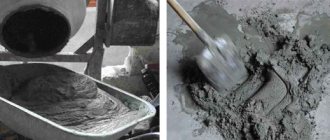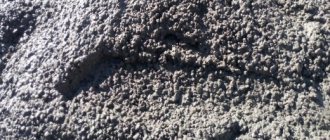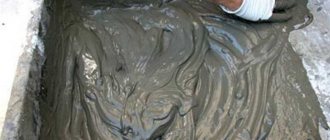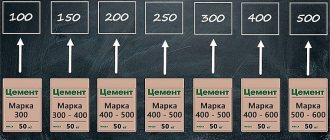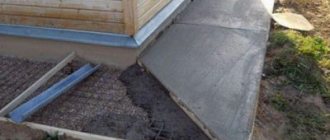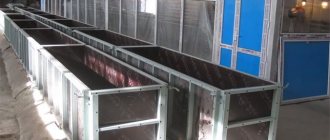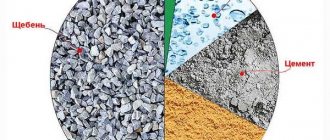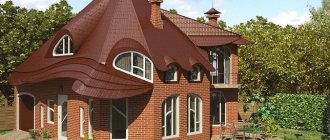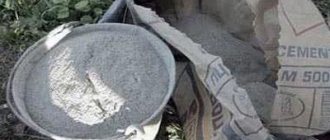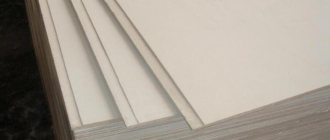Concrete is a stone building material obtained by hardening a semi-liquid mixture poured into a mold and compacted. It is prepared by mixing dry binder, fractionated aggregates and water. Cement is most often used as a binding element; aggregates are crushed stone, gravel, expanded clay, pebbles and crushed slag.
The main technical and operational indicator of such materials is the ultimate strength during a compression test, which allows you to determine the grade and class of concrete. At the same time, this brand indicates the average operational value of the strength of the hardened material, and the class is the maximum permissible indicator with the possibility of a small error.
In addition, the physical characteristics of concrete materials include marking for water permeability and frost resistance. The first indicator is very important in the construction of hydraulic and underground structures, and the second largely determines the durability of building structures built in cold and temperate climatic zones.
Classification parameters for concrete mixtures
Concrete mixtures are produced according to technological maps. Depending on the purpose, the material is given certain properties. The operating conditions of concrete structures determine the required characteristics.
The general classification of concrete is based on the following parameters:
- purpose: structural, special (with additives);
- density: heavy (more than 2000 kg/m3) and light (less than 2000 kg/m3);
- type of binder filler: cement, slag, gypsum, lime, polymer;
- structure: large-porous, cellular, porous, dense;
- type of filler: porous, special, dense.
The main indicators of concrete strength include grade and class.
Proportions of concrete of different grades
This entire range and range of qualities is obtained by using the same materials, just in different quantities. To achieve the required characteristics, the recommended proportions must be strictly observed.
When building your house, you want to do everything as best as possible, and therefore, when making concrete, you want to add more cement to make it stronger. This should not be done. It's unlikely to get better, but it could easily get worse. To gain strength, concrete needs a certain amount of water and other components. If there is little water, there is a lot of cement, bonds between particles are formed in insufficient quantities, which is why the concrete can crack and crumble. The same applies to the number of fillers. Both their too high and insufficient content negatively affects the qualities of concrete stone.
Concrete proportions are usually displayed in fractions. The amount of cement is taken as a unit, and the remaining components are prescribed in relation to it. The data is presented in the form of tables for the corresponding brands; the units of measurement must be indicated. You can see such a table of concrete components below.
Proportions of concrete of different grades from Portland cement M400 and M500
How to determine the required proportions of concrete using this table? In the second column, find the required grade of concrete. For example, you need an M250. Depending on which Portland cement you will use M 400 or M 500, choose one of two lines. The third column shows the proportions for concrete in kilograms: for 400 cement it is 1/2.1/3.9. This means this: to obtain concrete grade M 250, for 1 kg of Portland cement M400 you need to add 2.1 kg of sand and 3.9 kg of crushed stone. Similarly, determine the proportions for concrete M200 - the data for it in the table is slightly higher, or concrete M 300 - slightly lower.
The fourth column presents volume fractions: all components are given per 10 liters. They are selected in the same way.
Such tables do not indicate the amount of water. It depends on how thick the solution is needed. The water-cement ratio is given in separate tables. For example, below are data on the number of inputs in relation to a kilogram of cement, provided that medium-sized aggregates are used.
The amount of water to obtain concrete of the required grade when using medium-sized crushed stone and sand
For example, to obtain concrete grade M 300, the proportions of cement M 500 and water are defined as 0.61. This means that for 1 kg of cement, 0.61 liters of water (610 ml) are added to the solution. This produces a medium-plastic solution, which is used most often. But when pouring foundations or other structures with dense reinforcement, a plastic solution may be needed. Then, when determining the amount of water, in addition to the brand of cement, it is also necessary to take into account the size of the aggregates and how fluid the solution should be. These data are presented in the table below.
The amount of water in concrete depending on the size of crushed stone/gravel and the fluidity of the solution
Sometimes it is necessary to determine how much cement you will need for a particular task. To do this, you need to know how much cement is contained in a cubic meter of concrete. Data on concrete and cement grades can be found in the table below.
Amount of cement per cube of concrete
Strength classification
Grade (M) - an indicator of compressive and bending strength. Technical standards are determined by GOST 22 236 85. Testing of samples takes place on a special press. The strength grade directly depends on the amount of cement per unit of concrete mixture or aggregate.
M500 will mean that the structure can withstand pressure up to 500 kg/cm 3. The higher the concrete grade, the stronger it is, the faster it sets and hardens.
Strength depends not only on the proportional composition of the components, but also on the following factors:
- quality composition of water, filler;
- compliance with all necessary technological conditions;
- weather conditions at the time of pouring.
In order to clarify the strength indicator, the concept of concrete class was introduced. The tolerance for deviation from the norm is no more than 5%. Professional builders focus on the “class of concrete” characteristic, marked with the letter “B”. The SNiP 2.03.01-84 class indicator is regulated and describes standard indicators for various concrete and reinforced concrete structures.
Classification of concrete by grade (table)
| Concrete grade by compressive strength | Concrete class by compressive strength |
| M15 | IN 1 |
| M25 | B1.5-2 |
| M35 | B2.5 |
| M50 | B3.5 |
| M75 | AT 5 |
| M100 | B7.5 |
| M150 | B10-12.5 |
| M200 | B15 |
| M250 | IN 20 |
| M300 | B22.5-25 |
| M350 | B25-27.5 |
| M400 | B30 |
| M450 | B35 |
| M500 | B40 |
| M600 | IN |
| M700 | B20-21 |
| M800 | B22 |
Classification of concrete by class (table, with permissible deviations from standards).
| Class | Brand | Average strength, kgf/cm2 | Coefficient of variation (deviation of the brand from the class), % |
| B3.5 | M50 | 45,8 | +9,2 |
| AT 5 | M75 | 66,5 | +14,5 |
| B7.5 | M100 | 98,2 | +1,8 |
| AT 10 | M150 | 131,0 | +14,5 |
| B12.5 | 163,7 | -8,4 | |
| B15 | M200 | 196,5 | +1,8 |
| IN 20 | M250 | 261,9 | -4,5 |
| B22.5 | M300 | 294,7 | +1,8 |
| B25 | M350 | 327,4 | +6,9 |
| B27.5 | 360,2 | -2,8 | |
| B30 | M400 | 392,9 | +1,8 |
| B35 | M450 | 458,4 | -1,8 |
| B40 | M500 | 523,9 | +5 |
| B45 | M600 | 589,4 | +1,8 |
| B50 | M700 | 654,8 | +6,9 |
| B55 | 720,3 | -2,8 | |
| B60 | M800 | 785,8 | +1,8 |
| B65 | M900 | 851,3 | +5,7 |
| B70 | 916,8 | -1,8 | |
| B75 | M1000 | 982,3 | +1,8 |
| B80 | 1047,7 | -4,6 |
The table is compiled based on GOST 26 633-19.
Concrete class
The strength grade of concrete is directly related to the class of this material. However, the latter is a more accurate and specific meaning. After all, the quality of the finished concrete, in addition to the filler and the brand of cement, can be influenced by many other factors. For example, the type and purity of filler, sealer and binder, as well as pouring methods, hardening conditions, etc.
When determining the class of concrete, its grade, as well as correction factors, are taken into account. It is calculated according to the formula:
B = R*(0.0980655*(1 – 1.64*V)),
where R is the average strength of the material (grade),
V – coefficient of variation.
We found out that there is such a thing as concrete grades. Both their characteristics (the correspondence table will clearly show this) and the scope of use in most cases coincide with the classes. However, the latter indicator is indicated not in kgf/cm², but in pascals. The parameter 0.0980655 in the above formula is precisely the transition coefficient from one unit of measurement to another.
So, a certain brand of concrete usually corresponds to its specific class in terms of strength. However, sometimes the average and actual strength of this material differ quite significantly. In this case, the brand and class may not match. For example, concrete grade M200, due to the not very high quality of the filler or cement, may be designated as B10, not B15. The number in the class of a material shows its ability to withstand certain loads in MPa. Thus, B25 concrete can withstand pressure of 25 MPa without harm.
Of course, its cost also depends on the class of material. The solution is usually sold by volume. That is, the unit of measurement for which the price of such material is determined is a cubic meter. So, 1 m³ of a solution of class M100 costs about 2000 rubles, M200 will cost about 2200 rubles, and M300 can be bought for 3500 rubles.
Purpose of different grades of concrete in terms of strength
The strength of concrete, indicators M and B, determine the purpose of concrete mixtures. The classification of concrete is regulated by GOST 25 192 2012.
| Classification of concrete mixtures by grade (M) | Suitable for the following works |
| M100 | Preparatory construction work, concrete footing. |
| M150 | Preparatory foundation work, screeding floors, making paths. |
| M200 | Construction of low-rise construction structures, screed, sidewalk paths. |
| M250 | Flights of stairs are poured, separate supporting small structural elements. |
| M300 | A popular brand. Used in construction for casting structural elements of multi-storey buildings (supporting structures, floor slabs, staircases...) |
| M400; M450; M500 | They are used at sites with increased structural reliability: bridges, dams, subways, tunnels, cash storage facilities, swimming pools. |
| M600 | For the construction of high-strength structures and load-bearing structures of bridges, dams, dams, underground structures. |
Ready-mixed concrete grades
In listing the grades of concrete, we will go from “hard to soft”, that is, from hard grades of concrete to “softer” ones, it is correct to say lightweight concrete.
Concrete M550, class B45 is the most durable ready-mixed concrete. The proportions of cement in concrete grade M550 are maximum. It is used in production processes in the manufacture of special reinforced concrete products and in the construction of hydraulic structures.
Concrete M500, class B40, similar to concrete M550. Its purpose is also for buildings and products that are constantly in contact with water. Concrete grades M500 and M550 are extremely expensive.
Concrete grades M400, class B35 and M450, class B30, also belong to high-strength concrete, and are used in civil construction of structures close to water (waterworks, metro), as well as premises for special-purpose reinforced concrete products and bank vaults.
Concrete grade M350, class B25. This concrete is used to construct the foundations of multi-story buildings. It is this concrete that is the main one in the production of reinforced concrete products, monolithic construction, production of road slabs and hollow floor slabs. M350 concrete is indispensable for pouring concrete pools, load-bearing columns, and runways. In private construction, the use of M350 concrete is not rational.
Concrete grade M300, class B22.5. Popular ready-mixed concrete for the construction of strip, pile and other monolithic foundations, popular in private construction.
Concretes M200, class B15 and M250, class B20 are similar concretes in characteristics and applications. The foundations of low-rise buildings and small staircases are made from such concrete. This concrete is used to construct paths and blind areas around the house. It is quite reasonable to use concrete M200 or M250 for flooring in the garage.
Concrete grade M150, class B12.5 , is called lightweight concrete. Concrete of this brand is most common in private construction and rough finishing of premises. It is used to install subfloors in the house, fill walking paths, and level floors with screeds.
Concrete grade M100, class B7.5. Lightweight concrete used in preparatory work before reinforcement and in the construction of foundations.
Concrete grades M50 and M75. More often called cement mortars. Used in laying bricks and wall blocks, plastering works. It is distinguished by the absence of crushed stone and a large amount of cement and sand in the composition. In the everyday life of builders, such a solution is rarely called concrete. A more correct name is cement mortar or sand mixture.
Classification of concrete by frost resistance
The frost resistance of concrete, designated by the letter “F,” shows how many “freezing-thaw” cycles a concrete structure will withstand, maintaining its grade or strength class (up to 95%).
With an indicator less than F50, concrete structures are used only in frost-free closed rooms. Brands with indicators from F50 to F150 are in demand. They have proven themselves well in a cyclically variable climate zone.
Material with index F300 is used in low temperature operating conditions, in northern latitudes. For special objects with extreme weather and operating conditions, concrete F300 - F500 is used.
| Concrete grade | Concrete class | Frost resistance (F) |
| M100 | B7.5 | F50 |
| M150 | B12.5 | F50 |
| M200 | B15 | F100 |
| M250 | IN 20 | F100 |
| M300 | B22.5 | F200 |
| M350 | B25 | F200 |
| M400 | B30 | F300 |
| M450 | B35 | F200-F300 |
| M550 | B40 | F200-F300 |
| M600 | B45 | F100-F300 |
Basic characteristics of concrete
In the documentation for building materials, the brand is designated by the letter M, and the adjacent numbers indicate its strength. You can buy concrete with a strength of up to M1000, but grades in the M100-M450 range are widely used. The latter have successfully proven a sufficient level of strength for the construction of bridges, overpasses, runways and hydroelectric power plants.
The class of concrete is designated by the letter B and indicates the strength of the material and the level of load that it can withstand. To characterize concrete, indicators of frost resistance, water resistance, and rigidity are also used, which play an important role in a certain situation. It is recommended to purchase concrete strictly in accordance with the grades and other parameters important for the functioning of the future structure.
Water permeability
The structure of concrete structures has pores and capillaries. The higher the open porosity, the greater the water permeability. For aerated concrete it reaches 25%. Dense structural concrete has the lowest water permeability. The class is designated by the letter “W”.
In order to increase moisture resistance and frost resistance, plasticizers and modifiers are additionally used.
Incorrect calculation, selection of concrete mixture components, or excess water increases the water permeability of the material. During the process of concrete mixture shrinking and hardening, micro cavities are formed, which over time can fill with moisture. Therefore, at the time of pouring, compaction is carried out using vibrators to avoid the formation of air voids.
Classification of concrete according to strength class, frost resistance, water permeability (table):
| Concrete grade | Concrete class | Waterproof (W) |
| M100 | B7.5 | W2 |
| M150 | B12.5 | W2 |
| M200 | B15 | W4 |
| M250 | IN 20 | W4 |
| M300 | B22.5 | W6 |
| M350 | B25 | W8 |
| M400 | B30 | W10 |
| M450 | B35 | W8-W14 |
| M550 | B40 | W10-W16 |
| M600 | B45 | W12-W18 |
How to check concrete for compliance with GOST?
Concrete strength can only be tested in laboratory conditions. This requires special equipment. In principle, the preparatory process is simple. You need to pour the prepared solution into several cubes with an edge size of 10 cm. The solution is poured into a wooden box and, after hardening, should stand in this form for 28 days.
The cube should be stored in a place protected from sunlight at a temperature of +20 °C and a humidity of 95%. It is during this period that the concrete product is considered to reach its original strength.
After that, each cube is installed in a laboratory press, with which they are compressed one by one. Indicators of the tensile strength at which each cube begins to break are taken. The average value of each test is then established. This is strength. This is how the grade of concrete is determined.
Types of concrete by type of binder
Concrete is classified according to the type of main binder.
Among them are:
- Cement. Based on various grades of cement, the most common and sought-after type of concrete mixtures. They are used for interior and exterior construction work. Popular brands of concrete made on the basis of Portland cement.
- Special. Depending on the purpose, various types of fillers are added to cement mixtures, for example, fine metal shavings for strength. The addition of magnesite increases heat resistance, barite increases the protective properties of the material from the penetration of X-rays and radiation.
- Reinforced concrete. Reinforcement of concrete structures with metal.
- Slag-alkaline. They are made from slag-alkaline cement, which includes crushed slag. When adding alkaline components, a chemical reaction occurs between aluminosilicates and clay components. Its technical characteristics, frost resistance, water resistance, and strength are superior to cement-based concrete. Industrial waste and slag are disposed of. A promising direction for the development of the construction industry.
- Foam concrete. Foamed cement mixture with the addition of sand, water, construction fiber. It has low thermal conductivity and good moisture resistance. There are structural and heat-insulating foam concrete, and they are marked accordingly.
- Aerated concrete. Porous material, produced by autoclaving. Low thermal conductivity, but can absorb moisture.
- Fiber-reinforced concrete. Saturation of the cement mixture with fiber fiber gives it additional strength. This process occurs due to the fastening of all components together by many small fibers.
- Arbolit. Blocks made from cement and wood shavings. Warm material, but absorbs moisture.
- Kevlar concrete. It is made on the basis of marble, boundary chips, polyester resins, liquid glass with the addition of a catalyst. The result is an imitation of natural stone. Or using technology based on cement pellets, using a gravity concrete mixer.
- Polymer-cement. Polymer fillers and resins are added to cement. The concrete mixture acquires additional strength and is highly waterproof.
- Plaster. Used for finishing interior construction work. The addition of plasticizers, fiber, and other components increases strength and moisture resistance.
- Silicate. Made from silica, calcium oxide hydrate. Autoclave high temperature treatment increases strength.
The universal properties of the concrete mixture are that, depending on the composition of the components and additives, materials with a wide range of technical characteristics are obtained.
Concrete M100
Thus, we have reviewed in general terms what concrete grades are and their characteristics. The table shows that the scope of application of this material depends mainly on its strength. Next, let's take a closer look at how each class is specifically used. Material brand M100, for example, is not very strong. Therefore, it is usually used for plastering walls, carrying out preparatory work when pouring a road surface or constructing a foundation. In the latter case, the so-called footing is made from this material - a flat platform on which the reinforcement frame is installed.
Often this concrete is also used when installing curbstones that are not subject to special loads, pouring low-traffic sidewalk paths, etc.
The scope of application for concrete M150 is approximately the same. The material is quite durable for the construction of structures that are not subject to loads, but not reliable enough for pouring “serious” objects.
Classification by structure
There are dense, large-porous, cellular concretes. The higher the density of the material, the stronger the material.
Dense concrete mixtures are used for the manufacture of load-bearing structural elements. According to technical standards, the volume of air pores should not exceed a threshold of 6%. By introducing additives that involve air, porous concrete is obtained (air content no more than 12%). This structure reduces thermal conductivity and prevents delamination of the material.
Large-porous concrete mixtures are made without adding sand. Gravel fillers of different fractions are used as filler. The material is used for structures with low stress.
Cellular foam concrete and aerated concrete are made using additives that form pores inside the material. They have high thermal insulation properties. Used in low-rise construction. Or as a wall material for non-load-bearing structures for multi-storey buildings.
Preparation of concrete
For large volumes of work, it is better to order concrete from the factory. Making large quantities of mortar by hand or even using concrete mixers is a difficult task, and laying it in batches requires additional effort to ensure that the layers adhere well. However, you can prepare concrete manually. In this case, there are two sequences of actions:
- First, concrete and sand are mixed dry. It is mixed until the color becomes uniform. Then crushed stone is poured in, everything is mixed again, and water is added last.
- First, water is poured into it and cement is poured into it. When everything is mixed, add sand and then coarse aggregate.
The order of adding components for concrete during mixing may be different.
In the first option, there is a possibility that during manual mixing, unmixed composition will remain at the bottom, near the walls of the container, which will lead to a decrease in the strength of the concrete. The solution is to mix everything well and thoroughly. But you can’t spend too much time on this: the solution will begin to set.
The second option has its disadvantages: obtaining a homogeneous cement laitance (a mixture of water and cement) sometimes takes a lot of time. As a result, there is simply not enough of it to form bonds with the backfill: the cement “seizes” and the strength of the concrete also decreases.
All this is not so critical when using concrete mixers, but it is also not ideal. There is another difficulty here. Concrete is usually delivered to the construction site in carts. The entire volume does not fit into one, and the remainder is left to spin in a concrete mixer. This is better than leaving it just standing, but if you mix it too long, the solution may begin to delaminate, resulting in lower concrete strength. The solution is two carts and two people to carry them. The filling method - first or second - choose for yourself.
For small volumes, concrete can be mixed by hand
So after all, how to prepare concrete. The choice is yours. If the volumes are small, you can knead by hand. Just do it carefully. To pour the foundation, it is better to order a mixer, but you can also use a concrete mixer (or two, depending on the volume). And to solve problems with the heterogeneity of the mixture (although it is better that it is good), treat the concrete being laid with a vibrator. Most of the problems will go away.
Next, we’ll talk about the requirements for concrete components, their sizes and qualities.
Concrete aggregates
Placeholders serve several functions. Natural and artificial raw materials and production waste are used for these purposes. In concrete mixtures, depending on the specified technical characteristics, aggregates can make up 70-80% of the total mass.
Placeholder functions:
- give the material the necessary rigidity;
- protect against sudden shrinkage of cement paste;
- reduces the creep of concrete under conditions of increased loads.
Fillers differ in fractions, shape, and frost resistance. Check for radiation contamination.
Fine aggregates: sand, screenings of crushed stone, gravel. Ash and slag waste are used. The quality of fillers is regulated by the relevant GOSTs (8736 - sand; 25592 - ash and slag filler; 5578 - metallurgical slag).
Add to lightweight concrete:
- expanded perlite and vermiculite;
- pumice, tuff;
- expanded clay;
- thermosite;
- limestone;
- shell rock
Gravel and crushed stone are added to heavy concrete. For special concrete mixtures, other aggregates are used, depending on the technical requirements.
Types of concrete
Currently, the following grades of this material can be used in the construction of buildings and structures:
- super light;
- lungs;
- heavy;
- very heavy.
The concrete mixture is made using different types of fillers. The brand of the finished solution is determined by the type of the latter. Both light materials (for example, expanded clay or sawdust) and heavier ones (sand, crushed stone) can be used as filler. In industrial construction, special specialized concretes are sometimes used. They use metal shavings as filler. This solution is considered very heavy.
Frost resistance of concrete
The frost resistance of concrete is indicated by the letter F (25 - 1000), which means the number of freezing and defrosting cycles during which the mixture does not deform. This indicator is extremely important for foundations in very wet soils, bridge structures where there is constant contact with moisture, especially in autumn and spring during periods of temperature changes.
Various manufacturers additionally introduce antifreeze additives into the composition to increase the material’s resistance to temperature changes. Typically, such an additive is a hydrophobic (stressing) cement. Important: abuse of such means will result in a loss of concrete strength. For our climate zone, the use of concrete with frost resistance F 100-200 is suitable.
What grade of concrete is needed for the foundation of a house?
The reliability of the foundation of any structure is the key to its durability. Various types of concrete are used in construction, but if we are talking about the foundation of a house, then only heavy ones are used to load it into the formwork - this is an axiom. We will talk about how to choose the right brand for artificial stone.
Concrete mixtures for the foundation of a house.
Heavy concrete is called concrete in which the filler is fractions of rocks (mainly crushed stone of various types). The sizes of granules for the foundation of a private house are selected from 6 mm. Such solutions are designated by brand from M100 to M500.
What should you focus on?
There is no clear advice on choosing a solution. When deciding what kind of concrete is needed for the foundation of a house, you have to take into account a whole range of factors and, as a rule, look for a compromise option. In this case, the cost of production is not of paramount importance. Even the most expensive brand is characterized by certain restrictions in its use, so all further recommendations are only of a general plan.
1. Expected load.
When calculating it, the following components are taken into account:
- the material from which the house is built - brick, wood, aerated concrete or others. It is clear that the weight of the frame structure will be significantly lower than, for example, from reinforced concrete;
- number of floors of a private building;
- “filling” of the house - engineering equipment, household appliances, furniture, personal belongings. You also need to consider the prospect of purchasing something else.
When determining the grade of concrete for the foundation, it is necessary to ensure a certain margin of safety. Possible errors in calculations, errors and various force majeure circumstances cannot be ruled out.
- M100. As for a private house - if it is made of wood or aerated concrete on the 1st floor - this brand (with some restrictions) can be used. Although most often it is used only at the stage of preparation for laying the foundation. If grade 100 is chosen for a house (for example, aerated concrete), then a “cushion” of the same solution, at least 100 mm, must be installed.
- M150. For small light buildings. For example, if the house is being built from aerated concrete, cinder blocks and similar materials.
- M200. This brand is suitable for the foundation of a two-story house with a light ceiling. On such a foundation, prefabricated panel structures and buildings made of cellular concrete are often erected.
- M250. For the foundations of houses made of aerated concrete or wood, if they have no more than 3 floors.
- M300, 350. These grades are used for pouring foundations for heavy buildings. For example, when building a private house made of brick.
Pouring the strip foundation of the house.
- In some cases (on problematic soils and in other situations), concrete M400 and 450 is used. It is not advisable to use a grade higher than those indicated in the private sector. Such expenses can hardly be considered justified, given the high cost of the product.
- For a private brick building, the concrete grade M250 is selected for a strip foundation, provided that it is one-story.
There is an opinion that mortars of grades 200 and below are not used for arranging the foundation of a residential building of any type. However, opponents point out that factors such as soil properties, reinforcement density, and design features of the house should be taken into account. It is acceptable to use grades M100 – 200, but this is not a rule, but special cases. The choice of cheap brands should be made based on accurate calculations, since M350 is considered optimal for the construction of the foundation of a residential building (both in terms of the strength of the artificial stone and in price).
Under no circumstances are aerated concrete and its cellular analogues used for foundation construction!
Detailed table of proportions of concrete grade.
2. Soil characteristics.
- Sandstone, rock - such soils are homogeneous in composition, so the entire load on the base is distributed evenly. For lightweight houses, grades 150–250 are suitable, for more massive buildings: 300–400.
- Heaving soils (for example, clay, loam) - they are considered problematic in construction. The peculiarity is increased soil displacements during sudden temperature changes. In such conditions, it is not recommended to use a grade below 350 for the foundation.
The configuration of underground aquifers also matters. Taking into account the specifics of their location, you need to focus on such a characteristic as water resistance. It is relevant for houses with a basement floor.
Features of arranging the foundation of a house.
The base can be protected from contact with liquids by using better waterproofing, installing a reliable drainage system, and introducing hydrophobic additives. If you focus only on the brand, then you should know that the higher it is, the better the moisture resistance. This indicator is designated by the letter “W”. The grade of concrete for water resistance is expressed as a value from 2 (weak) to 8 (high).
When choosing a solution based on this characteristic, you need to calculate what is more profitable: purchase more expensive concrete (W7–8) or spend money on materials and carry out additional treatment of the foundation of the house.
A truly working legal way to save money. Everyone needs to know this!
3. Climate features.
Here frost resistance comes to the fore. It shows how many freeze/thaw cycles the concrete does not change its performance properties. In the marking it is indicated by the letter “F”. The result of an incorrect choice in this parameter is the appearance of cracks on the base and walls of the basement of a private house. In combination with other mistakes made (for example, during technological operations), this may appear after the first winter.
For our latitudes, it is advisable to purchase concrete with an index of at least F75 for the construction of the foundation, regardless of the brand.
Strength of compositions of different grades of concrete.
